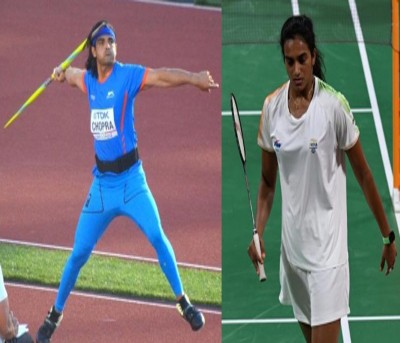
New Delhi, When it was launched in September 2014 by the Ministry of Youth Affairs and Sports, little did one know that the Target Olympic Podium Scheme (TOPS) would change the face of Indian sports and give wings to the aspirations of hundreds of athletes like never before.
Javelin thrower Neeraj Chopra clinching the 2020 Tokyo Olympics gold, shuttler PV Sindhu winning successive Olympic medals in 2016 Rio and 2020 Tokyo, are just a couple of the success stories spawned by the scheme that has given athletes the freedom to pick and choose their training destinations, competitions, coaches and mental trainers who can best serve their ambitions.
TOPS, the flagship programme of the sports ministry, might have had a low-key beginning in 2014 but following its revamp in 2018, which led to the establishment of a technical support team for managing the elite athletes and providing them with holistic support, it has grown from strength to strength and sportspersons now call it the gateway to success.
With a core group of more than 100 athletes across 13 disciplines and the men's and women's hockey teams besides around 300 'development group' athletes across 12 disciplines, the scheme has encompassed not just the most talented athletes vying for medals in events such as the Commonwealth Games, 2023 Asian Games and 2024 Paris Olympics but also those who are potential for the future.
One of India's most well-known and respected names in shooting, Mansher Singh, says the TOPS scheme mirrors the intention of the government to support the athletes in every way possible so they can win laurels for the country.
"When I was involved with the team, it was called NSDF (National Sports Development Fund) and they (sportspersons) had a cap on how much funding they could get in a year. I think TOPS now has upped that. It's gone to another level in the sense that there is no such limit. It (funding) now depends upon the athlete's requirement and obviously his profile in terms of winnability at the Olympics, his past performance etc," said Mansher, the Commonwealth Games gold medallist and multiple medal winner at the Asian Games.
TOPS has some of the most unique features, which make it an end-to-end 'one-stop shop' for an athlete committed to his goal of winning medals in major international competitions.
These include a professional set-up which is athlete-centric and involves potential-based selection, data analysis and research, athlete planning and athlete relationship management, international training sessions and visa facilitation support for sportspersons.
Each reasonable request made by an athlete is met with a positive and quick response and a top-of-line research support is on hand to track opponent performances. TOPS also provides a dedicated athlete relationship manager as a bridge between SAI and the athlete. So far, the scheme has facilitated around 400 foreign exposures in Olympic disciplines in the last four years.
Little wonder, every athlete who represents the country wants to be a part of the scheme, knowing that all his worries will be taken care of once he is part of the programme.
"They arrange everything for us. We don't have to spend a rupee from our pocket and as per the laid down norms, we get lodging, boarding and out-of-pocket allowance as per the government norms. This is over and above the requirement of an athlete competing at the highest level including training abroad, exposure trips, equipment, personal coaches and supports staff among others," says rifle shooter Sanjeev Rajput, who at 41 is aiming to secure an Olympic quota for the 2024 Paris Games after a disappointing show in 2020 Tokyo.
Following his below-par showing in Tokyo, he was dropped from the TOPS scheme and wants to quickly return to the fold with some good performances, which would guarantee him all the facilities required to work towards his goal of an Olympic medal.
Mansher Singh says the scheme has cut red tape to a bare minimum and with the TOPS analysts working "out of the domain of anyone's influence", it ensures that only the most deserving athletes are included in the scheme.
"It's a very professional process now. Projections are made, scores analysed and historical patterns observed to see how athletes are performing. Reputed analysts and professionals are constantly on the job of analysing athletes' parameters. The good thing about it (scheme) is that they do not function under anyone. They (TOPS analysts) are working out of the domain of anyone's influence. That is the greatest attribute of having an analysis team or a data-collection team or a team of specialists because they don't get influenced by anybody. They pick the best. They've done their research so they have the numbers," says Mansher.
He says that TOPS has now become a prestige thing where an athlete flaunts it like a "feather in his cap".
"You are finding more and more athletes who deserve and want to get into TOPS. It's now a prestige thing to get into TOPS because it's the ultimate thing for an athlete. For two-three years you get the best funding and best coaching. There used to be huge limitations on the amount of money that you could spend during my competition days. I think a lot of red tape from my NSDF days has gone, and now it's primarily based upon what is required for that athlete to win," he adds.
All in all a win-win situation for athletes provided they are willing to put in their best effort.


.jpeg)

